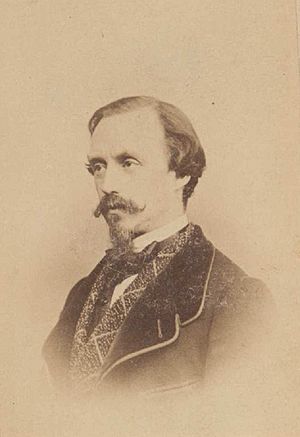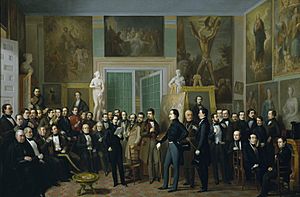Pedro de Madrazo y Kuntz facts for kids
Quick facts for kids
The Most Excellent
Pedro de Madrazo
|
|
|---|---|

de Madrazo; photograph by Jean Laurent
|
|
| Born |
Pedro de Madrazo y Kuntz
11 October 1816 Rome, Italy
|
| Died | 20 August 1898 (aged 81) Madrid, Spain
|
| Seat i of the Real Academia Española | |
| In office 10 April 1881 – 20 August 1898 |
|
| Preceded by | Antonio María Segovia |
| Succeeded by | Emilio Cotarelo |
Pedro de Madrazo y Kuntz was a talented Spanish man who did many things. He was a painter, a lawyer, a writer, a translator, and an art critic. He was born in Rome, Italy, on October 11, 1816. Pedro passed away in Madrid, Spain, on August 20, 1898.
Contents
Early Life and Education
Pedro came from a very artistic family. His father, José de Madrazo y Agudo, was a famous painter. His mother, Isabel Kuntz Valentini, was the daughter of another painter, Tadeusz Kuntze from Poland. Pedro had two brothers, Federico de Madrazo and Luis de Madrazo, who also became painters. His sister, Carlota, married Eugenio de Ochoa, who was an editor for a magazine.
Pedro and his brother Federico were born in Rome. At that time, their father was studying there with help from King Charles IV. Pedro started his schooling in Madrid at a seminary run by the Jesuits. After that, he studied law in Toledo and at the University of Valladolid, where he earned his degree.
In 1837, Pedro and Federico traveled to Paris, then returned to Rome. Soon after, Pedro married Manuela Rosales, whose father, Eduardo Rosales, was also a painter. They had three daughters and one son. During this period, Pedro also worked as an art teacher.
Career as a Writer and Journalist
Later, Pedro moved to Madrid. There, he, his brother Federico, and his future brother-in-law, Eugenio de Ochoa, started a magazine called El Artista. This magazine was very important for bringing the Romantic style of art and literature to Spain.
Pedro also wrote for many other cultural publications of his time. These included El Renacimiento, El Español, El Iris, La Cruz, and La Ilustración Española y Americana. He later became the editor of El Domingo magazine. In this magazine, he published poems that were similar to the Psalms and also translated parts of the Bible.
As a writer, Pedro enjoyed writing lyric poetry, which often had religious or moral messages. Sometimes, his poems also showed his love for his country. He also wrote two plays and some travel stories. He translated important books, including Criminal Law and Political Economy by Pellegrino Rossi. He also translated Book of Orators by Joseph-Marie Timon-David and History of the Consulate and Empire by Adolphe Thiers.
Legal and Public Service
Pedro combined his work in journalism with a career in law. He worked as an assistant and a prosecutor. In 1860, he worked for the Spanish Council of State. He served as the Secretary General for this council from 1870 to 1871, and again from 1875 to 1880. In 1888, he was a Minister in a special court called the "Tribunal de lo Contencioso Administrativo." He retired from his legal work in 1897.
Art Critic and Historian
Pedro was also a very important art critic and historian. He believed that Gothic art was the most important Spanish art style. He also helped introduce the idea that art should be seen as an important part of a country's history and heritage. He led a group that worked to protect historical monuments in different parts of Spain. Pedro also wrote the official catalogs for the famous Museo del Prado art museum.

Later Life and Achievements
In his later years, Pedro became the director of the Museo de Arte Moderno. In 1894, he took over from his brother Federico as the director of the Real Academia de Bellas Artes de San Fernando. He had been a member of this academy since 1851.
Pedro was also a member of the Real Academia Española, which focuses on the Spanish language. He was also part of the Real Academia de la Historia, where he worked as a secretary. He was also given special honorary memberships in several important institutions outside of Spain.
See also
 In Spanish: Pedro de Madrazo y Kuntz para niños
In Spanish: Pedro de Madrazo y Kuntz para niños

